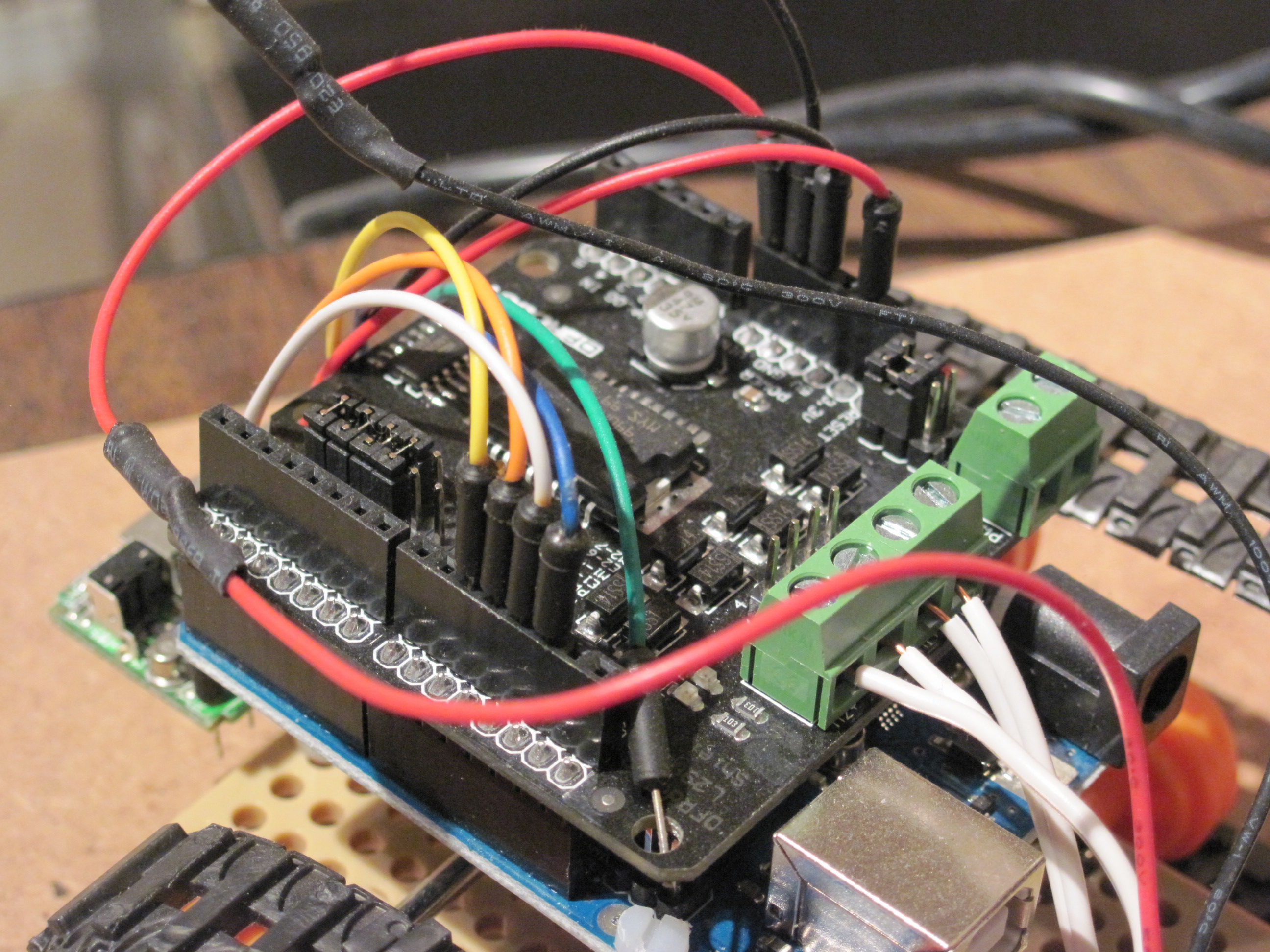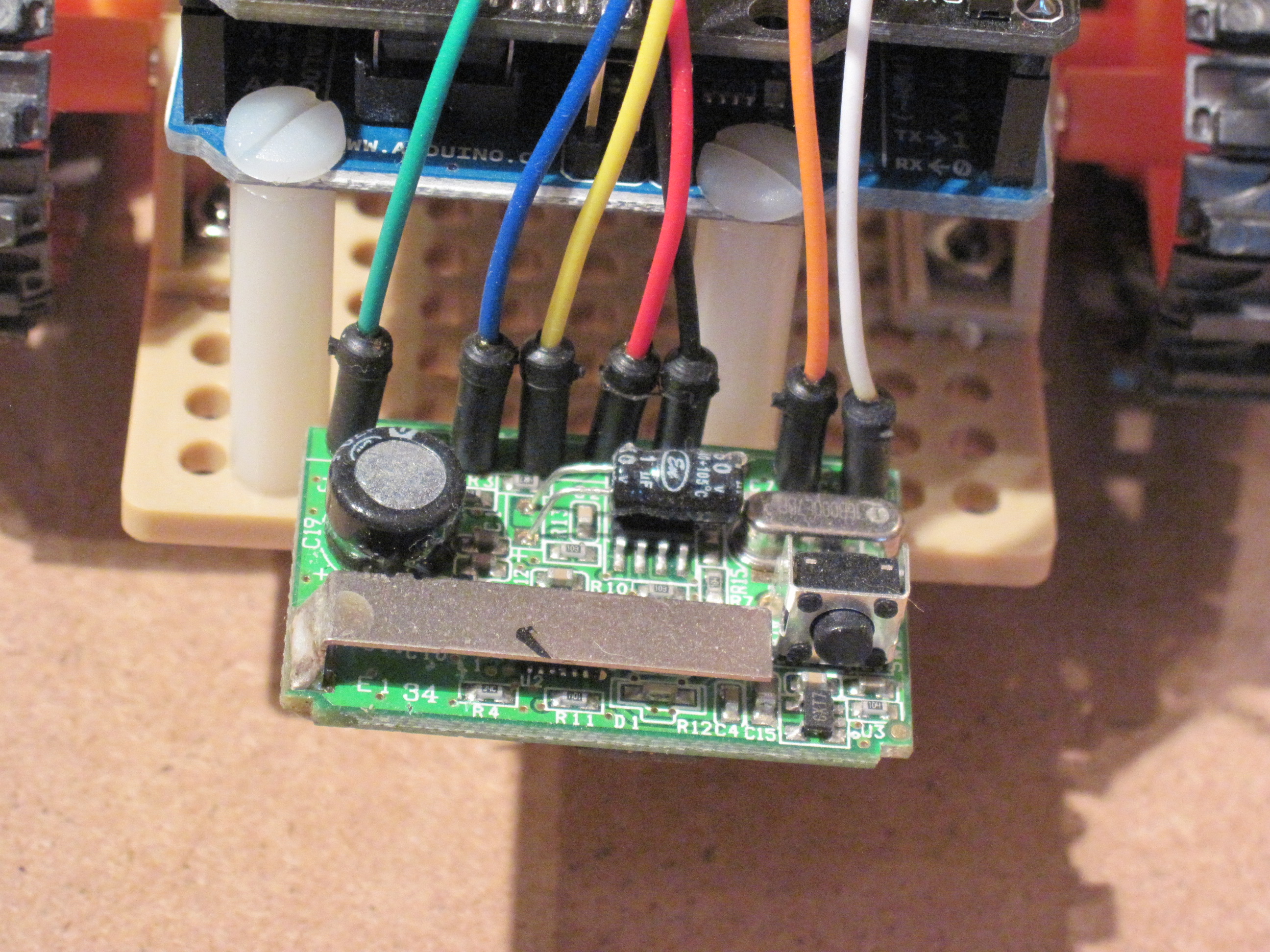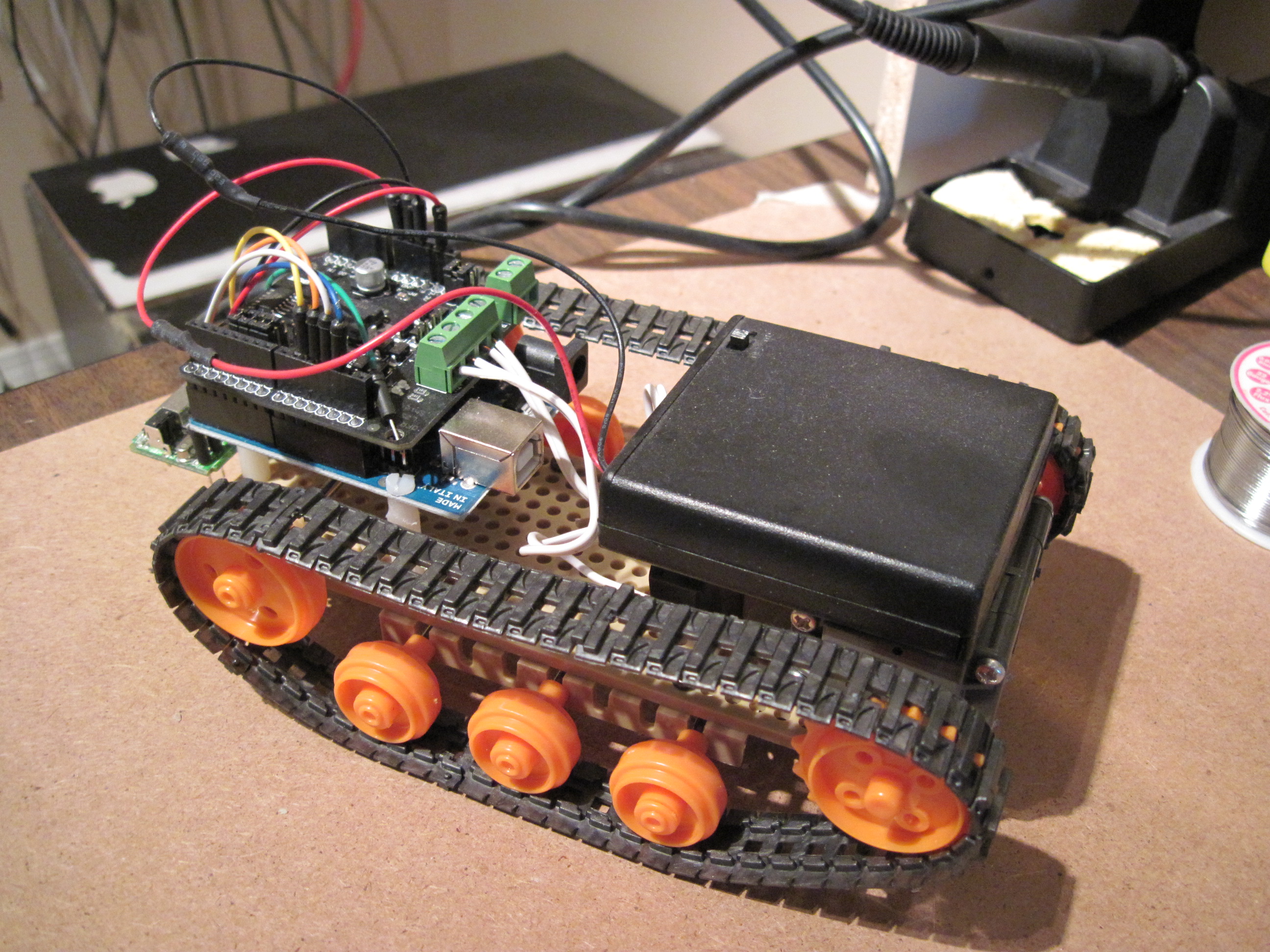A Simple Remote-Controlled Arduino Tank
By Paul Bleisch
A little while ago my son was showing some interest in robotics. His birthday was coming up and we were having trouble deciding between a beginner robot kit focused more on construction or lots of bits and pieces.
The kit we looked at was the Elenco OWI ATR - All Terrain Robot:

The alternative was to build a robot based around Arduino. There are many robotics kits out there but I liked the idea of investing in Arduino as the basis for exploring robotics. I figured we would get the Arduino Uno, a few shields to control motors and sensors and whatnot, throw some wheels on it, and blammo, have a robot.
Then the shopping set in. There is a multitude of places to buy a multitude of robot stuff. I was tempted by RobotShop's DFRobotShop Rover. Arduino compatible, everything we need to get started. And it was on sale at the time I was looking.
In the end, we bought our son the OWI ATR kit mentioned above for his birthday and I ordered a bunch of bits and pieces instead of the RobotShop Rover to build something more advanced with him. He really enjoyed the OWI ATR kit - he likes to build with his hands so it was the right balance of technology and construction.
For the Arduino robot project, I decided to start with a simple remote controlled tank. I really had no specific plan though I had searched around a bit on YouTube and such to see that others had managed to throw something together. I ordered everything from Amazon though not everything was fulfilled by Amazon so I paid shipping for a few things. Otherwise, I tried to spend as little as possible.
For the mechanicals, I used cheap Tamiya plastic bits. The instructions on these are not the most verbose but my son and I managed to stumble through without any damage to ourselves or the parts.
For the brains behind the operation, I went with a fairly stock setup with an Arduino Uno and a Motor Shield from DFRobot.
Additionally, I wanted to use a wireless Playstation controller for the remote control. I picked up a used Logitech wireless PS2 controller from my local Gamestop (since closed). You can find them on Amazon as well.

Another option is the Hydra PS2 controller.

I allowed myself a bit of luxury by buying jumper wires.

A battery pack to hold four AA batteries seemed like enough power.

Assembly of the chassis was straightforward...

After building the chassis, the motor, and doing a quick test with the battery pack connected directly to the motors, I moved on to attaching the Uno and motor shield, I had some 1.5 inch nylon standoffs with screws that I used to mount the Arduino complex to the chassis. I did another quick test controlling the motors using the Arduino + Motor Shield.

//Arduino PWM Speed Control for DFRobot Motor Shield
//
int E1 = 6;
int M1 = 7;
int E2 = 5;
int M2 = 4;
void setup()
{
pinMode(M1, OUTPUT);
pinMode(M2, OUTPUT);
}
void loop()
{
int value;
for(value = 0 ; value <= 255; value+=5)
{
digitalWrite(M1,HIGH);
digitalWrite(M2, HIGH);
analogWrite(E1, value); //PWM Speed Control
analogWrite(E2, value); //PWM Speed Control
delay(30);
}
}
Finally, I tore apart the wireless dongle for the PS2 controller, soldered on some jumper pigtails and connected it to the Arduino. Using PS2X from Bill Porter, I got basic remote control working pretty quickly.

// Glue together PS2X controller code with DFRobot Motor Shield code
//
#include <PS2X_lib.h> //for v1.6
PS2X ps2x; // create PS2 Controller Class
//right now, the library does NOT support hot pluggable controllers, meaning
//you must always either restart your Arduino after you conect the controller,
//or call config_gamepad(pins) again after connecting the controller.
int error = 0;
byte type = 0;
byte vibrate = 0;
//Arduino PWM Speed Control for DFRobot Motor Shield (default pins)
int E1 = 6;
int M1 = 7;
int E2 = 5;
int M2 = 4;
int lmotor = 0;
int rmotor = 0;
void setup()
{
Serial.begin(57600);
// set pin modes for DFRobot Motor Shield
pinMode(M1, OUTPUT);
pinMode(M2, OUTPUT);
error = ps2x.config_gamepad(13,11,10,12, true, true); //setup pins and settings: GamePad(clock, command, attention, data, Pressures?, Rumble?) check for error
if(error == 0)
{
Serial.println("Found Controller, configured successful");
Serial.println("Try out all the buttons, X will vibrate the controller, faster as you press harder;");
Serial.println("holding L1 or R1 will print out the analog stick values.");
Serial.println("Go to www.billporter.info for updates and to report bugs.");
}
else if(error == 1)
{
Serial.println("No controller found, check wiring, see readme.txt to enable debug. visit www.billporter.info for troubleshooting tips");
}
else if(error == 2)
{
Serial.println("Controller found but not accepting commands. see readme.txt to enable debug. Visit www.billporter.info for troubleshooting tips");
}
else if(error == 3)
{
Serial.println("Controller refusing to enter Pressures mode, may not support it. ");
}
type = ps2x.readType();
if (type != 1)
{
Serial.println("warning: DualShock Controller Not Found!");
}
}
void loop()
{
if(error == 1) //skip loop if no controller found
return;
if (type == 1)
{
ps2x.read_gamepad(false, vibrate); //read controller and set large motor to spin at 'vibrate' speed
lmotor = 0;
if (ps2x.Button(PSB_L1))
lmotor = 255;
if (ps2x.Button(PSB_L2))
lmotor = -255;
rmotor = 0;
if (ps2x.Button(PSB_R1))
rmotor = 255;
if (ps2x.Button(PSB_R2))
rmotor = -255;
}
else
{
lmotor = 0;
rmotor = 0;
}
// update motors
if (lmotor < 0)
{
digitalWrite(M1, LOW);
analogWrite(E1, -lmotor); //PWM Speed Control
}
else
{
digitalWrite(M1, HIGH);
analogWrite(E1, lmotor); //PWM Speed Control
}
if (rmotor < 0)
{
digitalWrite(M2, LOW);
analogWrite(E2, -rmotor); //PWM Speed Control
}
else
{
digitalWrite(M2, HIGH);
analogWrite(E2, rmotor); //PWM Speed Control
}
delay(30);
}
Overall, the little tank worked pretty well and we had fun building it. I think the four AA batteries aren't really enough to power the system as I couldn't drive both motors in opposite directions simultaneously (or there is a bug in my code which is equally possible).
 Since we built this, I've used the Arduino for a number of projects (yet to be posted) and picked up an Ultrasonic sensor that we've yet to put into use on the tank. That'll have to be a future post.
Since we built this, I've used the Arduino for a number of projects (yet to be posted) and picked up an Ultrasonic sensor that we've yet to put into use on the tank. That'll have to be a future post.

Updated: A Mostly Complete Parts List
Here's the items I used with links to Amazon (based on looking at my order history).
- Tamiya 70168 Left/Right Independent 4 Speed Double Gearbox
- Tamiya Track and Wheel Set TAM70100
- Tamiya Universal Plate TAM70098
- Arduino UNO board
- Motor Shield for Arduino
- Breadboard jumper wire 75pcs pack
- Logitech PlayStation 2 Cordless Action Controller
(I actually bought mine used from a local Gamestop)
- 4 x 1.5V AA Battery Case Holder
(Note that this links to Amazon but I actually bought mine from a local electronics store.)
- Nylon Spacers and Screws (for mounting Uno to chassis)
Update 1
Here is a Fritzing diagram for this project.

Update 2
A few people have asked for book recommendations for learning to code for Arduino. My son found the following book useful when he was doing projects with Arduino.





